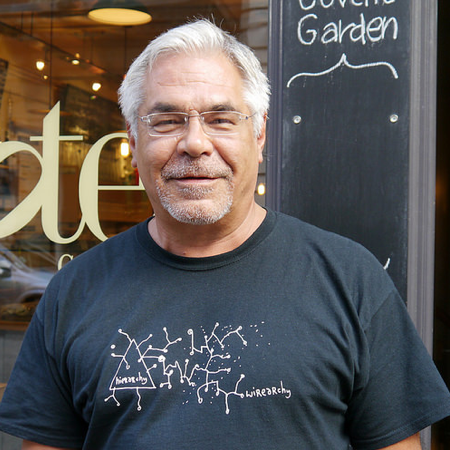 Wirearchy is an emergent organizing principle that informs the ways that purposeful human activities and the structures in which they are contained are evolving from top-down direction and supervision (hierarchy’s command-and-control) to champion-and-channel … championing ideas and innovation, and channeling time, energy, authority and resources to testing those ideas and the possibilities for innovation carried in those ideas.
Wirearchy is an emergent organizing principle that informs the ways that purposeful human activities and the structures in which they are contained are evolving from top-down direction and supervision (hierarchy’s command-and-control) to champion-and-channel … championing ideas and innovation, and channeling time, energy, authority and resources to testing those ideas and the possibilities for innovation carried in those ideas.
The working definition of Wirearchy is “a dynamic two-way flow of power and authority, based on knowledge, trust, credibility and a focus on results, enabled by interconnected people and technology”.
Each of the four core elements of the principle is a domain unto themselves. Many hundreds of books have been written about each of them as specific subjects. Knowledge, trust, credibility and seeking results are fundamental to connecting, exchanging in order to gossip, learn, share useful current information, find out how to do things, explore ideas, build and operate effective organizations, carry out effective government and governance, and so on.
Interconnected access to information, knowledge and instantaneous communications provides the modern equivalent to the dynamics created by the invention of the printing press – information distributed (much) more widely throughout society. Today it is also the case that the information is exchanged almost instantly; certainly at speeds that allow the back-and-forth rhythm of a conversation but in ways that leave a pragmatic actionable record of that conversation.
At the individual level .. it is now clear that data about individuals is formidable fuel for igniting and stoking information-based services across the range of human activities. As we are moving into a new chapter of the internet’s impact on human society, we are beginning to examine the ownership of and power contained in personal data combined with software, interconnectedness and the arrival and ubiquity of mobile devices. The hi:project combines a number of the most recent key issues and developments in a way that speaks directly to the ongoing shifts in power related to increased density and reach of information circulation and use.
Today’s rapid flows of information are like electronic grains of sand, eroding the pillars of rigid traditional hierarchies. This new set of conditions is having real impact on organizational structures and the dynamics these structures generate, contain and also block. In turn this impact is growing into massive change in the ways we do things and behave. Traditional hierarchy-related power (having shape in the models of goods and services pushed at individuals) is beginning to shift as information and interconnectedness allow individuals to pull information and services towards them. This augments the notion of personalization, and lays the foundation for conceiving and articulating the hi:project.
Some of this is exhilarating, and great. Some of it is not. Some of it is about greater confusion, stress and frantic action. Some of it is about clarity, calm and right action. Polarities are appearing everywhere. Different dimensions and dynamics of influence, power and control are emerging at various nodes of interconnected networks of purpose.
The last thirty years have been about the building of the technical infrastructure that provides an interconnected world. The integrated platform for a transformation to economies and a world driven by the communication and exchange of information is now solidly in place.
The next fifty years will almost certainly be about learning how we will behave in an interconnected world and workplace. The dynamics of wirearchy are similar to, and different than, traditional hierarchy – yet need effective and transparent hierarchical structure and action to work smoothly.
Jon is speaking at the inaugural hi:project meetup this evening.
[Photo of Jon by David Terrar, 10th October 2014, Covent Garden, London.]
3 thoughts on “A new chapter of the internet’s impact on human society”
Comments are closed.